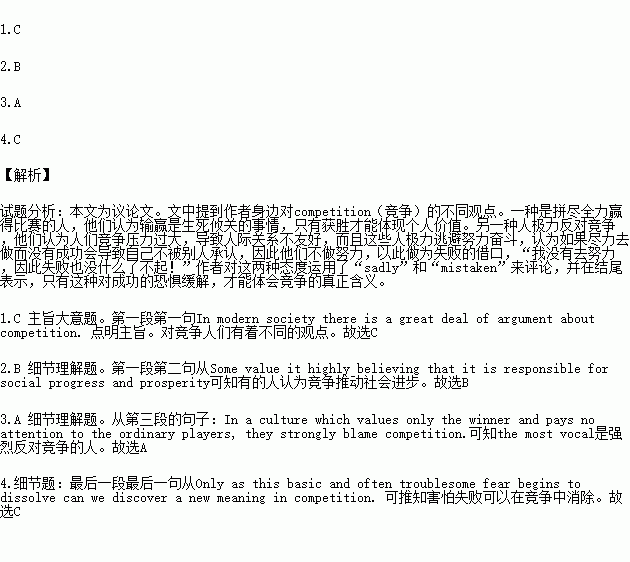题目内容
In modern society there is a great deal of argument about competition. Some value it highly, believing that it is responsible for social-progress and prosperity. Others say that competition is bad; that it sets one person against another; that it leads to unfriendly relationship between people.
I have taught many children who held the belief that their self-worth relied on how well they performed at tennis and other skills. For them, playing well and winning are often life-and-death affairs. In their single-minded pursuit of success, the development of many other human qualities is sadly forgotten.
However, while some seem to be lost in the desire to succeed, others take an opposite attitude. In a culture which values only the winner and pays no attention to the ordinary players, they strongly blame competition. Among the most vocal are youngsters who have suffered under competitive pressures from their parents or society. Teaching these young people, I often observe in them a desire to fail. They seem to seek failure by not trying to win or achieve success. By not trying, they always have an excuse: "I may have lost, but it doesn't matter because I really didn't try." What is not usually admitted by themselves is the belief that if they had really tried and lost, that would mean a lot. Such a loss would be a measure of their worth. Clearly, this belief is the same as that of the true competitors who try to prove themselves. Both are based on the mistake belief that-one's self-respect relies on how well one performs in comparison with others. Both are afraid of not being valued. Only as this basic and often troublesome fear begins to dissolve (缓解) can we discover a new meaning in competition.
1.What does this text mainly talk about?
A. Competition helps to set up self-respect.
B. Competition is harmful to personal quality development.
C. People hold different opinions about competition.
D. Failures are necessary experience in competition.
2.Some people favor competition because they think it __.
A. builds up a sense of pride
B. pushes society forward
C. improves social abilities
D. develops people's relationship
3. The underlined phrase "the most vocal” in Paragraph 3 refers to those who
A. are strongly against competition
B. highly value competition
C. try their best to win
D. mostly rely on others for success
4. Which viewpoint does the author agree to?
A. Self-worth relies on winning.
B. Competition leads to unfriendly relationship.
C. Fear of failure should be removed in competition.
D. Winning should be a life-and-death matter.
 阅读快车系列答案
阅读快车系列答案
